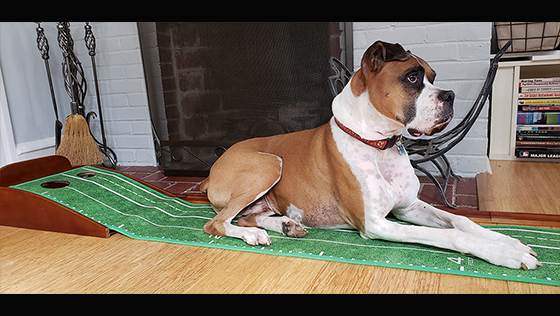Blog
After Impressive PNC, What’s Next for Tiger?

The switch flipped around the turn. Tiger Woods had been in hit-and-giggle mode for the previous two-plus days of the PNC Championship, content to play a few shots and crack a few jokes. Let us not forget that the man nearly lost his leg in February. But Tiger felt better from the moment he woke up Sunday morning, and Team Woods had the lead in sight. The smiles turned to fist-pumps. The wandering eyes locked in on the prize. Something about that Sunday red-and-black.
Tiger and Charlie put on one helluva show, dropping 11 straight birdies from Nos. 7-17 at the Ritz-Carlton Golf Club to briefly tie Team Daly for the lead. There was, incredibly, a legitimate buzz in the air for a December exhibition featuring three kids too young to drive and two men older than 80. Virtually every single spectator on site followed the Woodses all day, and those hotel guests who couldn’t score the hot ticket found a hillside where they could glimpse the action. It was the group behind, however, that produced the champion: John Daly, still smokin’ his smokes and drinking his Diet Cokes, and John Daly II, now a freshman on the Arkansas golf team and no longer Little, put in a spoiler performance that’d make 2009 Stewart Cink proud.
The Woodses’ 15-under 57 came up two shots short, in solo second, but now we’re talking semantics. Tiger will be beaming on the 30-minute flight back to Jupiter—for the way he played, the way he felt and how his 12-year-old son composed himself and performed in the high-tension moments.
Charlie Woods played a high, soft cut into the 16th green. Start it in the middle of the green, let it move toward the hole. Just like dad. Birdie. And then he topped that on the next hole, the difficult par-3 17th, when he held a 5-iron into a right-to-left wind and snuggled his ball to three feet from a water-guarded front-right flag. It was the closest anyone got on that hole, including the pros. Birdie. Both Tiger and Charlie knew they needed to eagle the par-5 finishing hole, a distinct possibility after Tiger’s second crawled just over the green. As he approached his ball, the sun gleaming off his forearms and his eyes locked on a landing spot, context flew out the window. This was Tiger being Tiger.
“The competitive juices, they are never going to go away. This is my environment. This is what I’ve done my entire life,” Tiger said afterward. “I’m just so thankful to be able to have this opportunity to do it again. Earlier this year was not a very good start to the year, and it didn’t look very good. But the last few weeks, to push as hard as we have the last seven months with taking no days off and just working our butts off each and every day, and to have this opportunity to be able to play with my son and to have these memories, for us, for both of us, our lifetime, it’s worth all the pain.”

Team Woods shot an impressiive 15-under 57—with 11 straight birdies—on Sunday to finish second.
Jensen Larson for Golf Digest
This week was always going to be a test for Woods. He’d played only two or three rounds all year, and certainly not three days in a row. He’ll be encouraged that he had noticeably more speed and pop on Sunday than the previous two days. He also had much better bottom-control, which is tour speak for being able to have the club interact with the turf/ball at the same time over and over. There were no drop-kick drivers, like there were on Saturday.
Justin Thomas, who Woods played with on Saturday, still came away beaming. “I was so impressed by the speed that he had and the shots he was hitting,” Thomas said. “At least from my perspective, it looked like a lot of the moves and everything were there.”
For all that’s been made of Woods ushering in the power era of golf, his strength has always been his irons. They have survived five knee surgeries and five back surgeries, and, for the moment, a horrific car accident. Woods had tour-level distance control all week and looked comfortable shaping the ball both ways. There were high cuts and there were low draws. The shot he hit into the par-3 eighth—a 4-iron cut that pierced through the wind and still sat soft, those are Tiger shots. There were a lot of Tiger shots this week. More than anyone expected.
“Way impressed,” said Sunday playing partner Matt Kuchar, who has played his fair share of golf with his fellow 40-pluser. “He’s still flushing it. Still has speed. Irons are spectacular. Tiger Woods of old-like irons. Huntin’ flags, pin high every time. It’s awesome.”
His driver swing is noticeably different; he’s much more flat footed at impact, a nod to the fact he’s not yet comfortable pushing off his right leg and clearing onto his left side during the downswing. There’s more wrist action at the bottom that he’d like. Because he cannot generate the speed with his legs, much of it comes from the arms. It is, ironically, somewhat analogous to the way Phil Mickelson generates speed. Whether he’ll move back toward that squat-and-clear motion as his leg strengthens remains to be seen. So much remains to be seen.
If this week proved anything, it’s that Tiger still has the game. He can still hit the golf shots … so long as he has a ride to the next one. For a man who has lived a complicated life in the public eye, his greatest challenge moving forward is, ironically, so very simple: walking. It boils down to whether he can walk 18 holes for five straight days. Because, as his caddie Joe LaCava reminded us this week, tournament golf requires a practice round. Even for Tiger. And that’s to say nothing of the practice ramp-up he’ll need to get the game to a place where it can stand up to Rahm and Rory and rough. Because of the scramble format, and the Woods boys’ overall proficiency at golf, we still haven’t seen Tiger hit a single shot out of rough.
“I’m not … I’m not at that level. I can’t compete again these guys right now, no,” Tiger said. “It’s going to take a lot of work to get to where I feel like I can compete at these guys and be at a high level.”

Tiger rides in a golf cart with his girlfriend, Erica Herman, and his daughter, Sam Woods, during Sunday’s final round.
Ben Jared
Woods did fatigue as the afternoon wore on. There were a number of grimaces. But pain—pain he can deal with. His leg has its structural integrity back; doctors told him there was no risk of further injury this week. It would just be a matter of pain management.
As for what’s next, it’s more of the same. Gym work and physical therapy, every single day, multiple times per day. Woods, who turns 46 next Thursday, said earlier this week that he has not taken a single day off in his rehab. This, a taste of the intoxicating rush of competition, will only motivate him further.
“As I told you guys in the Bahamas, I’m not going to play a full schedule ever again. I’m going to have to pick and choose what events, and even then, my body might not cooperate with that. So I don’t know how many events I’m going to be playing in. And it’s going to be up to training sessions, practice sessions, recovery tactics, all those different things to be able to do it. As I said … [I’m] protective on it now, and just so thankful to be able to do this again because it didn’t look good there for a little.”
Earlier this week, Woods scoffed at the notion of requesting a cart for a PGA Tour event. “That’s just not who I am,” he said. “That’s not how I’ve always been.” He will take exactly zero handouts on his road back, which is nowhere near its completion. And yet this week cannot be considered anything but a hugely encouraging sign.
As for the future, well, we likely won’t hear much from Tiger over the next few months. He seems to prefer dropping news out of nowhere and sending the internet into a frenzy. Until then, or until he steps into the public eye once again, he’ll return to a cadence of living that’s become all too familiar: rehab, rehab, rehab.

This article originally appeared on Golf Digest.
Blog
The Mental Game of Golf: Mastering the Psychology Behind Lower Scores

It’s a scenario every golfer knows intimately: you’ve just striped a perfect drive down the middle of the fairway, only to follow it up with a chunked iron shot that barely advances the ball. Frustration mounts, your focus shatters, and the rest of the hole—and perhaps the round—unravels. While we often blame our swing mechanics for these inconsistencies, the true culprit frequently lies between our ears. Research consistently shows that the mental game accounts for a staggering 70-90% of performance in golf . Yet, despite its monumental importance, studies reveal that only about 14% of golfers regularly practice their mental skills .
This article is designed to change that. We will explore the critical role of psychology in golf, break down the most common mental errors that sabotage your scores, and provide you with professional-grade techniques and practical drills to build an unshakeable mental game. By the end, you will have a clear roadmap to not only lower your handicap but also to find more joy and resilience on the course.
Why the Mental Game is Your Most Important Club
In golf, a quiet mind is a powerful asset. Your mental and emotional state directly influences your physical capabilities. When you are calm, focused, and confident, your body is relaxed, and your swing can flow freely and naturally. Conversely, when you are anxious, angry, or distracted, your muscles tighten, your coordination suffers, and your swing mechanics break down. This isn’t just a feeling; it’s a physiological reality. Negative emotions trigger a fight-or-flight response, which is fundamentally at odds with the fine motor control required for a successful golf shot .
A 2025 systematic review on mental fatigue in golf further highlights this connection. The research found that prolonged mental exertion during a round directly leads to a decline in performance, affecting everything from driving distance and iron accuracy to, most significantly, putting . Every decision, every calculation, and every moment of frustration depletes your cognitive resources, making it harder to execute shots as the round progresses. Mastering the mental game is therefore not just about thinking positively; it’s about efficiently managing your mental energy.

The 5 Mental Mistakes Costing You Strokes (and How to Fix Them)
Based on extensive analysis of amateur golfers, sports psychologists have identified several recurring mental errors. Here are five of the most common, along with strategies to overcome them, adapted from the work of mental game coach David MacKenzie .
Mental Mistake Description The Fix 1. Analyzing Your Swing Constantly dissecting your mechanics on the course, trying to “fix” your swing mid-round. Trust the swing you brought. The course is for playing, the range is for practicing. Focus on your target and let your body execute. If you need a swing thought, use a simple rhythm cue like “one-two-three.” 2. Obsessing Over Score Tying your emotional state to your score on every hole, leading to a rollercoaster of feelings. Focus on the process, not the outcome. Your goal for each shot should be to execute your routine flawlessly. The score will take care of itself. 3. Negative Self-Talk Berating yourself after a bad shot, which lowers confidence and increases tension. Become your own best caddy. After a poor shot, offer yourself the same encouragement you would a friend. Develop a post-shot routine that involves acknowledging the feeling, taking a deep breath, and moving on. 4. Vague Targeting Aiming for a general area like “the fairway” or “the green” instead of a specific point. Pick the smallest possible target. Top professionals aim at incredibly precise spots, like a specific tree branch or a single blade of grass. This sharpens focus and improves accuracy. 5. Neglecting Your Routine Lacking a consistent pre-shot and post-shot routine, leading to inconsistent mental preparation and reaction. Make your routine your primary goal. A well-defined routine is your mental armor against pressure. It ensures you are committed to every shot and can handle any outcome.
Building an Unshakeable Mental Game: Pro-Level Techniques
Top professional golfers are masters of the mental game. They employ specific techniques to stay focused, confident, and resilient under immense pressure. Here are a few you can incorporate into your own game.
The Power of a “Pre-Shot Creation”
Instead of a rigid, robotic pre-shot routine, think of it as a “pre-shot creation.” This concept, inspired by the approach of players like Tiger Woods, reframes the process as an artistic and imaginative one . Rather than just going through the motions, you should feel the shot, engage your senses, and become genuinely interested in the unique puzzle each shot presents. This fosters a state of deep presence and curiosity, quieting the analytical mind.
Tiger Woods worked extensively with navy psychologist Dr. Jay Brunza early in his career, developing what he called “game training.” Woods emphasized the importance of bringing attention to “THIS SHOT in THIS moment” and described feeling the shot in his fingers rather than relying solely on visualization. At his best, Woods found a way to be immensely interested in each shot, playing from a position of curiosity rather than anxiety .

Mastering Your Mind: Awareness Over Control
One of the biggest paradoxes in golf psychology is that trying to control your thoughts often backfires. Telling yourself “don’t hit it in the water” only makes the water a more prominent feature in your mind . The key is not to suppress negative thoughts but to change your relationship with them through mindfulness and awareness. Acknowledge the thought without judgment, and then gently guide your focus back to your target and your breathing. The best players don’t have fewer negative thoughts; they are simply more skilled at not letting them take over.
Research shows that the average person has approximately 70,000 thoughts per day, with more than two-thirds being negative . The difference between elite golfers and amateurs is not the quantity of negative thoughts but how they respond to them. Elite players have developed the skill of awareness—noticing thoughts without becoming entangled in them—allowing the thoughts to pass like clouds in the sky.
Breathe Like a Champion
Breathing is one of the most powerful and simple tools for managing your physiological state. When you feel pressure mounting, your breathing becomes shallow and rapid. By consciously slowing it down, you can signal to your nervous system that it’s time to calm down. A popular and effective technique is Box Breathing:
1.Inhale slowly for a count of four.
2.Hold your breath for a count of four.
3.Exhale slowly for a count of four.
4.Hold your breath for a count of four.
Repeating this cycle just a few times can significantly lower your heart rate and reduce muscle tension, allowing you to approach the shot from a state of calm focus .

The Science Behind Mental Training
Recent research validates what professional golfers have known intuitively for decades. A brain training study conducted with UCLA Golf demonstrated remarkable results: participants increased their greens in regulation by 12% and decreased three-putts per round by 9.7%. Perhaps most impressively, these improvements were sustained eight weeks after the training concluded . This demonstrates that mental skills, like physical skills, can be trained and improved with consistent practice.
A 2024 neuroscience study revealed that expert golfers exhibit distinct brain activity patterns during successful putts compared to unsuccessful ones. The research emphasized that mental preparation—not just physical technique—is the key differentiator between making and missing putts . This finding underscores the importance of developing a consistent mental routine before every shot.
Putting It Into Practice: Drills for a Stronger Mind
Improving your mental game requires consistent practice, just like your swing. Here are a few drills you can incorporate into your routine:
Pressure Putting Drill: Place three balls at 3, 6, and 9 feet from the hole. You must make all three in a row to complete the drill. If you miss, you start over. This simulates pressure and forces you to focus on your routine for each putt. As you improve, increase the difficulty by adding more balls or extending the distances.
Mindfulness on the Range: During your practice sessions, take a few moments between shots to simply be present. Feel the grip in your hands, notice the breeze, and listen to the sounds around you. This trains your ability to stay in the present moment, which is essential for peak performance on the course.
Post-Round Journaling: After each round, take five minutes to write down one thing you did well mentally and one mental challenge you faced. This builds self-awareness and helps you identify patterns in your mental game. Over time, you will notice recurring themes that you can address in your practice.
Target Practice with Consequences: On the range, pick a specific target for every shot—not just a general area. If you miss your target, perform a small penalty like five push-ups or hitting the next shot with your opposite hand. This adds consequences to your practice, making it more similar to on-course conditions where every shot matters.
Key Takeaways for Your Next Round
As you prepare for your next round, keep these fundamental principles in mind:
Trust over control. The more you try to consciously control your swing, the more tension you create. Trust the swing you have practiced and let your body execute naturally.
Process over outcome. Make your pre-shot routine your primary goal for every shot. When you focus on executing your process flawlessly, good scores follow naturally.
Awareness over suppression. You cannot eliminate negative thoughts, but you can change your relationship with them. Notice them, acknowledge them, and gently return your focus to the present moment.
Precision over generality. Always pick the smallest possible target. This sharpens your focus and gives your subconscious mind a clear objective.
Compassion over criticism. Treat yourself with the same kindness and encouragement you would offer a playing partner. Negative self-talk only compounds mistakes and drains your confidence.
Conclusion
The journey to mastering the mental game of golf is ongoing, but it is one of the most rewarding pursuits in the sport. By understanding the profound impact of your mind on your performance, recognizing common mental errors, and consistently practicing proven psychological techniques, you can unlock a new level of consistency, resilience, and enjoyment on the golf course. Remember, the next time you step onto the tee, your most powerful tool isn’t in your bag—it’s in your head. The difference between a good round and a great round often comes down to how well you manage the six inches between your ears.
Start small. Pick one technique from this article—perhaps developing a consistent pre-shot routine or practicing Box Breathing before important shots—and commit to it for your next three rounds. Track your progress, notice the changes, and gradually incorporate additional mental skills into your game. The mental game is not a quick fix, but a lifelong practice that will serve you well both on and off the course.
References
[1] NeuroTrackerX. (2023, December 1). Why Golf Performance is 90% Mental.
[2] McCarthy, P. (2025, November 8). The Mental Game of Golf: Pro Secrets You Haven’t Heard Before.
[3] Colorado Senior Golfers’ Association. The Brain Game – Spring Edition.
[4] McCarthy, P. (2025, November 8). The Mental Game of Golf: Pro Secrets You Haven’t Heard Before.
[5] Pan, X., et al. (2025). Mental fatigue in golf: A systematic review. PLOS ONE.
[7] Mind Caddie. (2025, November 9). Tiger Woods’ Mental Strategies.
[9] MyTPI. Mental Game: Brain Training Study With UCLA Golf.
[10] PsyPost. (2024, August 15). Golf: New neuroscience study reveals the secrets of better putting.

Golf, often perceived as a male-dominated sport, has seen numerous women defy norms, break barriers, and challenge the status quo. These pioneering women have not only made significant strides in the game but have also played a crucial role in reshaping the sport’s landscape. This article delves into the impressive careers of some of these groundbreaking women in golf, highlighting their incredible achievements and the enduring impact they’ve had on the sport.

Babe Didrikson Zaharias: The Woman Who Redefined Golf
Named “Woman Athlete of the Half Century” by the Associated Press in 1950, Babe Didrikson Zaharias is undoubtedly one of the most remarkable athletes in history. Her golfing career was nothing short of extraordinary.
Triumph Against the Odds
Despite facing resistance from the golfing establishment for her flamboyant personality and style of play, Zaharias refused to be sidelined. She won a staggering 10 LPGA major championships and 41 LPGA tour events, setting stage records and leaving an indelible mark on the sport.
Paving the Way for Others
Zaharias also co-founded the Ladies Professional Golf Association (LPGA), creating more opportunities for women in professional golf. Her tenacity and resilience inspired countless women to pursue their golfing aspirations, forever changing the face of the sport.

Nancy Lopez: A Beacon of Inspiration
Nancy Lopez is another trailblazing woman in golf. A child prodigy, Lopez first made waves in the golfing world when she won the New Mexico Women’s Amateur at just 12 years old.
.jpg)
A Stellar Career
Lopez turned professional at the age of 21 and quickly established herself as a dominant force in women’s golf. She won 48 LPGA Tour events, including three major championships, and was inducted into the World Golf Hall of Fame in 1987.
Inspiring Future Generations
Lopez’s impact extends far beyond her impressive record. She is widely respected for her sportsmanship, dedication, and spirit, and her success has inspired many young girls to take up golf.
Annika Sorenstam: Shattering Glass Ceilings
Annika Sorenstam is widely considered one of the greatest female golfers of all time. The Swedish star boasts an astounding 72 LPGA Tour victories, including 10 majors.
Making History
In 2003, Sorenstam made history by becoming the first woman in 58 years to compete in a PGA Tour event. This monumental moment not only put the spotlight on women’s golf but also challenged the gender divide in the sport.
Championing Women’s Golf
Post-retirement, Sorenstam has remained a powerful advocate for women’s golf. Through the Annika Foundation, she works to provide opportunities for young female golfers and promote the sport at the grassroots level.
Conclusion: The Legacy of These Trailblazing Women
The contributions of Zaharias, Lopez, and Sorenstam to golf are immeasurable. They’ve not only shattered records and broken barriers but also opened doors for countless women in the sport. Their legacies serve as a testament to the power of determination, talent, and hard work. They have reshaped the world of golf, proving that the fairway is no longer just a man’s domain.
These women have paved the way for the next generation of female golfers, who continue to push boundaries and redefine the sport. As we celebrate these pioneering women, we look forward to seeing more women rise, conquer, and leave their own mark on the fairways.
Today, women in golf continue to make strides, thanks in part to the trail blazed by these pioneering women. Let their stories inspire you to break barriers in your own field, whatever that may be. Because when it comes to achieving greatness, the most important shot in golf, as in life, is the next one.
Blog
Sustainability in Golf: The Future of Eco-Friendly Greens
Read about the environmental impact of golf courses.

Golf, a sport often associated with pristine, manicured greens and lush landscapes, isn’t historically perceived as eco-friendly. However, with growing concerns about climate change and sustainability, the golf industry is steadily transitioning towards more sustainable practices. This article will explore how golf courses around the world are becoming greener and more eco-friendly while maintaining their appeal to golf enthusiasts.

The Environmental Impact of Golf Courses
Golf courses traditionally use extensive resources, including water, pesticides, and fertilizers, which can have detrimental effects on the environment.
-
-
- Water Usage: Maintaining the verdant landscapes of a golf course requires enormous amounts of water. This is particularly concerning in regions where water scarcity is a significant issue.
- Pesticides and Fertilizers: To keep golf courses lush and free of pests, large amounts of chemicals are often used. These substances can seep into the ground, polluting water sources and harming local wildlife.
- Habitat Disruption: Golf courses often displace natural habitats, upsetting local ecosystems and reducing biodiversity.
-

Green Initiatives in Golf: Sustainability on the Fairways
Recognizing the environmental impact, many golf courses are now implementing sustainable practices to reduce their ecological footprint.

Water Conservation
Water conservation is a significant focus in eco-friendly golf course design. Methods employed include:
-
-
- Recycled Water: Many golf courses are now using recycled water or rainwater for irrigation, significantly reducing the use of freshwater resources.
- Drought-resistant Grass: Some courses are opting for drought-resistant varieties of grass that require less watering.
- Irrigation Technology: Advanced irrigation systems can efficiently distribute water, minimizing waste.
-

Reducing Chemical Usage
Reducing the use of harmful chemicals is another crucial step towards sustainability in golf. This can be achieved through:
-
-
- Organic Fertilizers and Pesticides: Many golf courses are switching to organic alternatives, which are less harmful to the environment.
- Integrated Pest Management: This approach focuses on long-term prevention of pests through biological control and habitat manipulation, reducing the need for chemical pesticides.
-

Preserving Local Habitats
Golf courses are increasingly being designed to coexist harmoniously with local ecosystems. This involves:
-
-
- Preserving Natural Features: Instead of altering the landscape to fit the course, designers are now incorporating existing natural features into the design.
- Creating Wildlife Habitats: Some golf courses are creating habitats for local wildlife, promoting biodiversity.
-
Case Studies: Sustainable Golf Courses Around the World
There are several golf courses worldwide that serve as excellent examples of sustainability in the industry.
- Pebble Beach Golf Links, USA: This renowned golf course uses recycled water for irrigation, reducing its freshwater use by 50%.
- St Andrews Links, Scotland: Known as the “Home of Golf”, St Andrews Links has implemented an extensive environmental management plan, including water conservation, habitat protection, and the use of organic fertilizers.
- Vineyard Golf Club, USA: This golf course in Massachusetts is one of the first to become fully organic, using only organic fertilizers and pesticides.
The Future of Sustainable Golf
The golf industry’s move towards sustainability is not just about eco-friendly practices on the course. It’s also about educating players and visitors about the importance of sustainability, thus promoting a culture of environmental consciousness.
While the transition to greener practices may be challenging, the benefits are immeasurable. Sustainable golf courses not only help protect the environment, but they can also enhance the playing experience, offering golfers the chance to play their favorite sport while surrounded by thriving, natural landscapes.
In conclusion, as awareness of environmental issues continues to grow, the question of “how green can the greens get?” is being answered by golf courses worldwide. Through innovative practices and a commitment to sustainability, the future of golf looks set to be greener than ever. As players, supporters, and enthusiasts of the sport, we can all contribute to this positive change by supporting golf courses that prioritize sustainability and by advocating for green practices within the golfing community.
-

 Product Review6 years ago
Product Review6 years agoThe Perfect Practice Putting Mat Review by Jason Tenzer
-

 Blog4 years ago
Blog4 years agoLoophole Rule Offers PGA Tour Pros a Mulligan
-

 Blog4 years ago
Blog4 years ago2021 Buyer’s Guide: The Top 10 Value Golf Balls For Distance & Feel
-

 Blog5 years ago
Blog5 years agoGolf Marriage Counselor
-

 Blog6 years ago
Blog6 years ago9 Biggest Chokes Of The Past Decade
-

 Product Review6 years ago
Product Review6 years agoTHE ADJUSTABLE IRONS: WALKING STICKS GOLF CLUBS
-

 Blog4 years ago
Blog4 years agoWhat Your Golf Clubs Say About You
-

 Equipment6 years ago
Equipment6 years agoOHK Sports Interview by Jason Tenzer



























